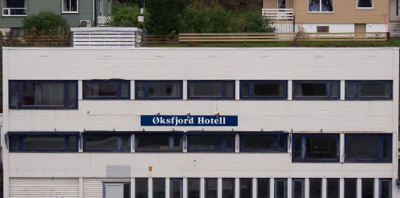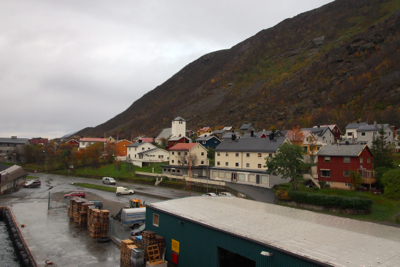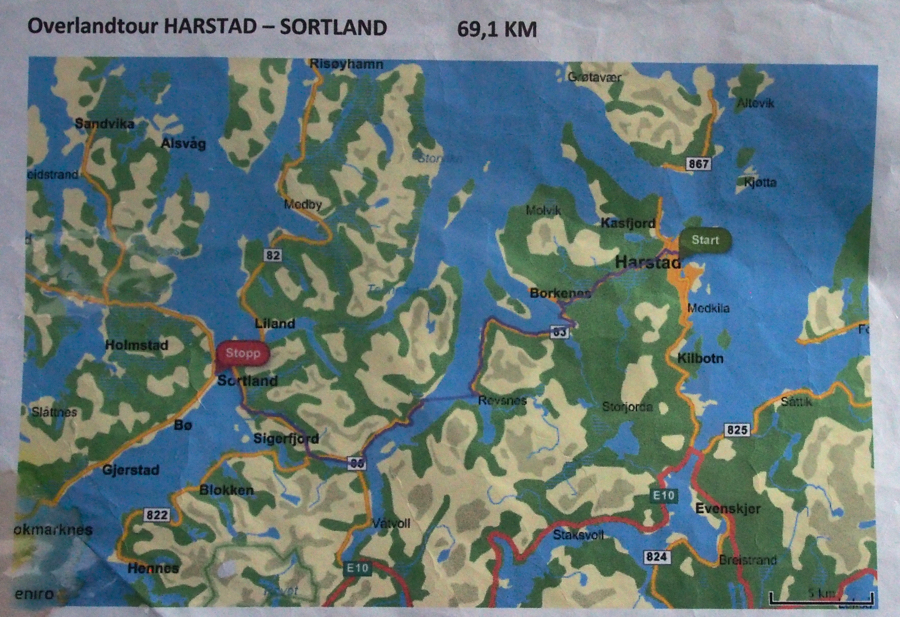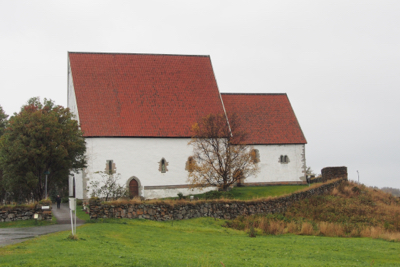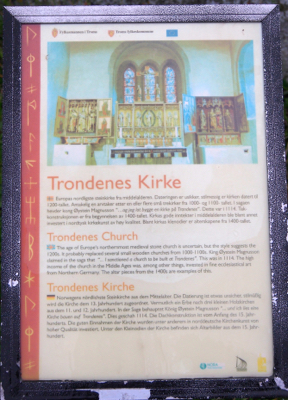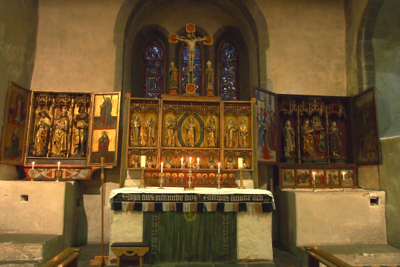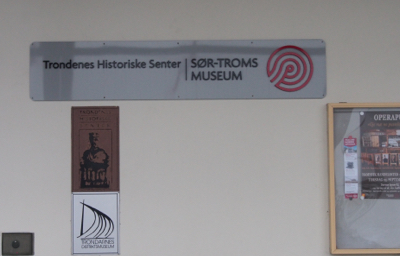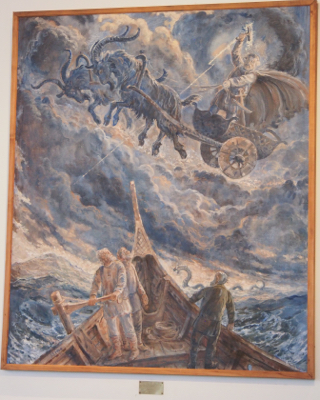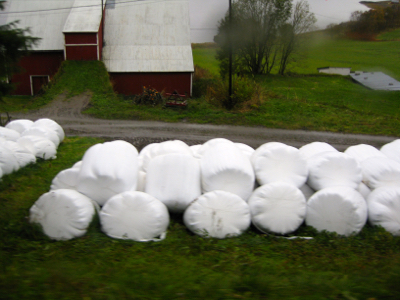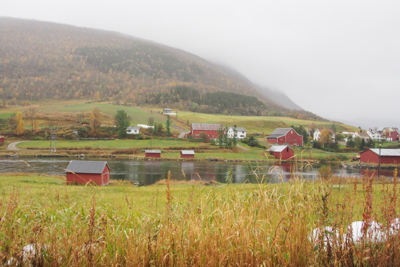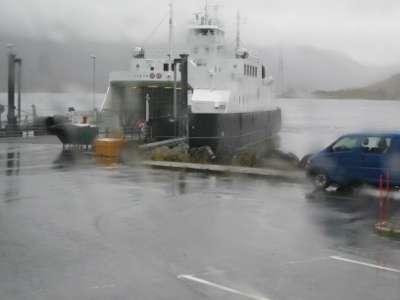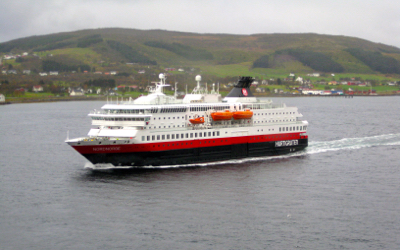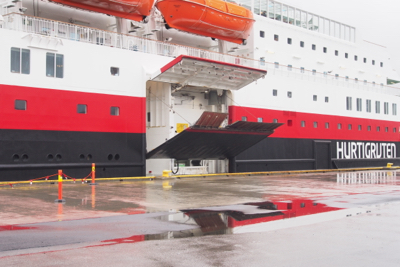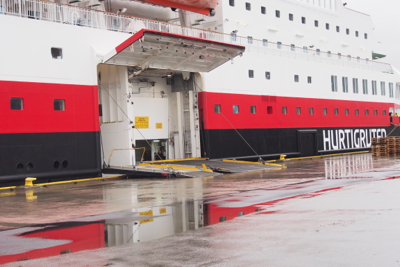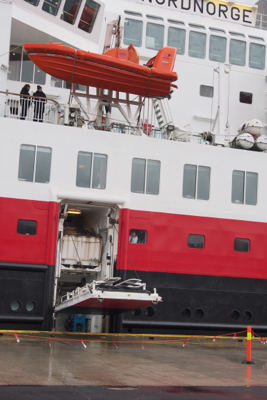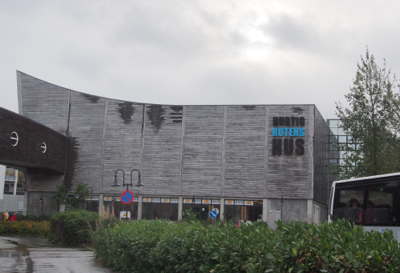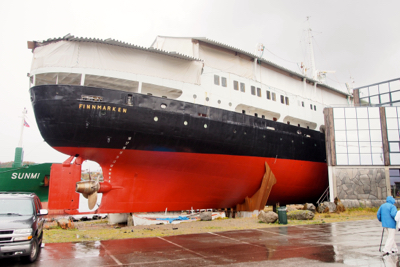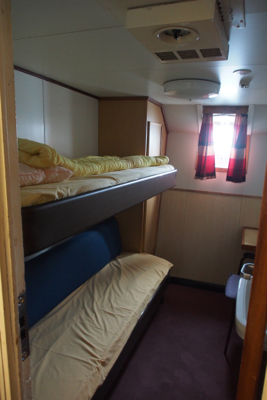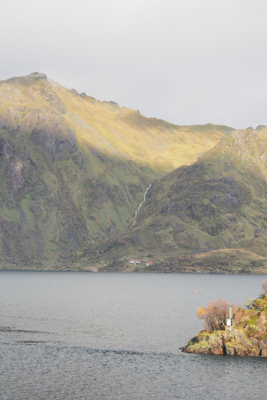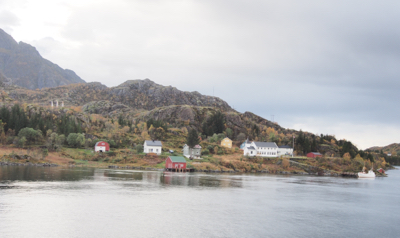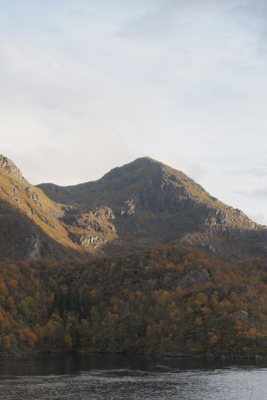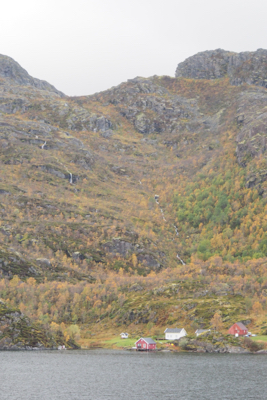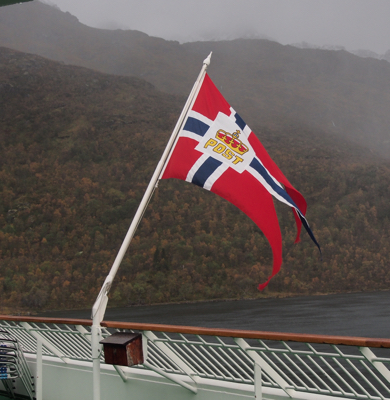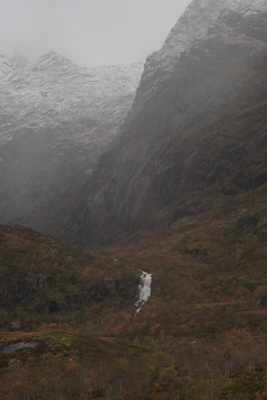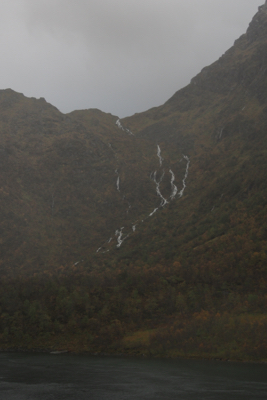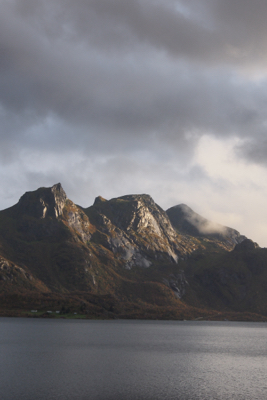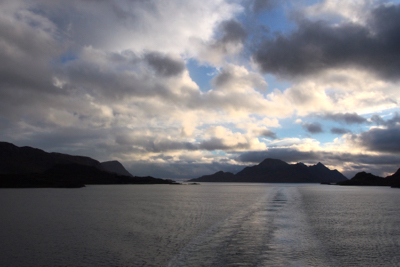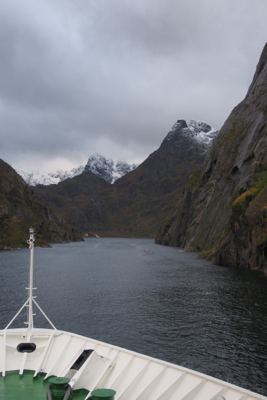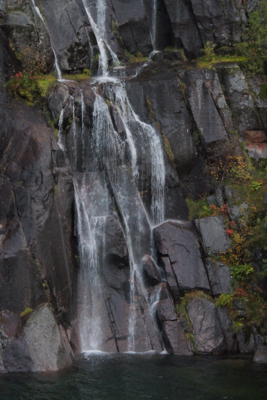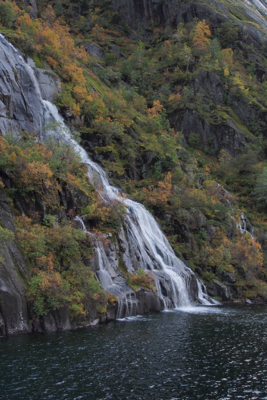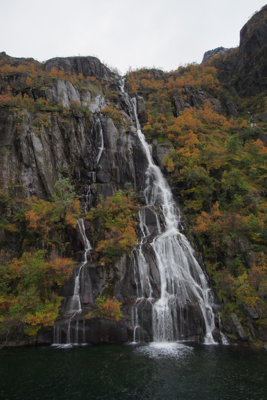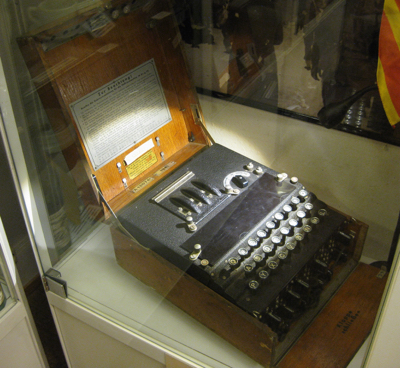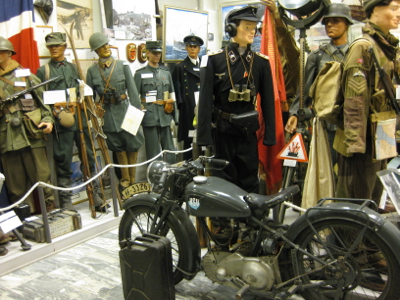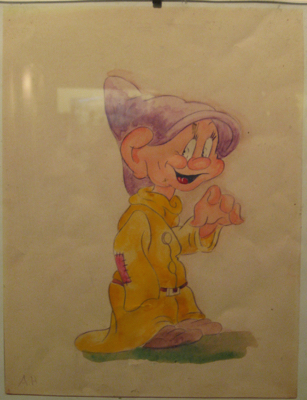Fri., 10/2/15 – Norwegian Coast
We booked a ship excursion called Vesteralen Panorama to take us inland across two of the Lofoten Islands. We disembarked at 8:10 in Harstad and got on a tour bus with an English-speaking guide. It rained for the entire four-hour trip. This is normal weather up here! The fjord at Harstad once had lots of herring, which was the main source of income for the town. By the 1970’s the fjord was fished out but the fishing was restarted after new regulations were instituted.
Harstad was the port where all allied troops landed in northern Norway (Finnmark). It was heavily bombed and has been rebuilt. We visited the Trondenes Church that was built in 1250. It is a medieval church and the “northern-most” stone church. It was also rebuilt after the war. We went inside to see the 1400’s altarpiece and the Lutheran minister led a short service for the 100 people on this excursion. He recited the 23rd Psalm in English and then in German. We recited the Lord’s Prayer and sang “Praise to the Lord, the Almighty, the King of Creation” in our own several languages. The minister gave a benediction in two languages. I thought it was appropriate.
We walked from the church to the museum, Trondenes Historical Centre, in the rain. We had 45 minutes to wander through the nice exhibits which ranged from pictographs from the stone-age to the rise of the Vikings, to the development of the fishing industry, to WWII occupation and destruction.
Another mail stop
Oksfjord
Vesteralen Panorama Tour from Harstad (upper right) to Sortland (left center) - blue/purple line
Trondenes Church
Trondenes Church
Trondenes Church
Trondenes Historical Centre
Painting - Trondenes Historical Centre
Hay bales - “troll marshmallows”
We had a photo-stop at a tidal lake that has both fresh water and salt water fish. The tide was rushing out as we crossed over the bridge to get back on our bus. Through the rain on the windows we looked out at several fish farms and sheep in many small green pastures. There are not many trees this far north!
Our bus loaded onto a ferry to take us across the Gullesfjord to the second on many Lofoten islands. The ride was 20 minutes and we walked up to the top deck for included coffee and snacks. We drove along Sigerfjord (Long Water Bay) to Sortland. We saw a herring oil plant and the area where an avalanche slid down and killed four women and their eight children. Their husbands were out at sea fishing. All that is left are the foundations of the four houses. As we crossed the high bridge into Sortland, our ship sailed underneath it (a staged event).
Tidal lake
Ferry across the Gullesfjord
MS Nordnorge approaching Sortland to pick us up
Nordnorge going under our bridge - staged affair
The design of our ship for both cargo and passengers is very interesting. The ports (openings to the outside) on the ship are all hydraulically controlled. If you look into the cargo bay, you can see the cargo moving equipment and everything is highly organized. Fascinating - someone gave this a lot of thought and got the design right.
Cargo port
Cargo port
Passenger port
After lunch Eva took us to the Hurtigruten Museum on the dock at Stokmarknes. We visited an old Hurtigruten ship, the Finnmark, and walked through the decks to look at the old wheelhouse and old-time cabins. We are glad our ship is much more modern and comfortable. We walked back to the museum and looked at exhibits showing the history of the “Coastal Express.” Shipping started delivering mail along the northern coast because a letter was taking three to six months to get delivered. After 1881 the Coastal Express could deliver it in six to 10 days. Later, not only mail but supplies and later still passengers and cars were carried on the Coastal Express. The tourist business was the latest addition. Hurtigruten now has 11 modern ships in constant movement.
Hurtigruten Museum
Finnmark
Finnmark cabin
Fjord country - Stokmarknes to Svolvaer
Fjord country - Stokmarknes to Svolvaer
Fjord country - Stokmarknes to Svolvaer
Fjord country - Stokmarknes to Svolvaer
Fjord country - Stokmarknes to Svolvaer
Norwegian Postal Service flag - MS Nordnorge is a Norwegian Postal Boat
Fjord country - Stokmarknes to Svolvaer
Fjord country - Stokmarknes to Svolvaer
Fjord country - Stokmarknes to Svolvaer
Fjord country - Stokmarknes to Svolvaer
We sailed through a narrow spot called Raftsundet and later into Trollfjord. This was a small fjord with 3,000 foot nearly vertical cliff walls. Since it was still raining, there were many waterfalls. As our ship turned to head out, the bow was only about 10 feet from the rock wall indicating how steep and deep the shoreline is.
The Trollfjord
The Trollfjord
The Trollfjord
The Trollfjord
The Trollfjord
After dinner we docked at Svolvaer and Eva took us to see the Lofoten War Museum with William Hakvaag's WWII collection. This man has spent years and megabucks collecting all kinds of WWII equipment, uniforms, etc. Three items caught our interest: an enigma code machine used by the Germans to encipher messages. The Brits got hold of one and used it in Bletchley Park where very intelligent women used it to decode those messages, allowing the Allies to know what the Nazis were doing. There was a section of iron railroad track with Krupp’s name emblazoned on it. The Krupp coffee machine is made by this same family that produced the iron for Germany’s war machinery. The third item was a painting by Hitler, who liked to paint but was not accepted into the German Art Institute. Behind the picture William found three more paintings by Hitler. While he was sending Jews and Poles to death camps he painted pictures of Dopey, Sleepy, and Doc from the Disney film of Snow White and the Seven Dwarfs. He was definitely psychotic. We walked a little in the pouring rain before returning to the ship.
Lofoten War Museum - An Enigma Machine
Lofoten War Museum
Lofoten War Museum - from the Krupp Foundry
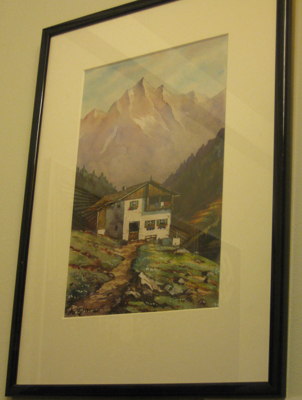
Lofoten War Museum - paintings attributed to Hitler
| Return to Top | Return to Itinerary | Return to Trips page to view other trips | Return to Dreamcatcher Home Page |
